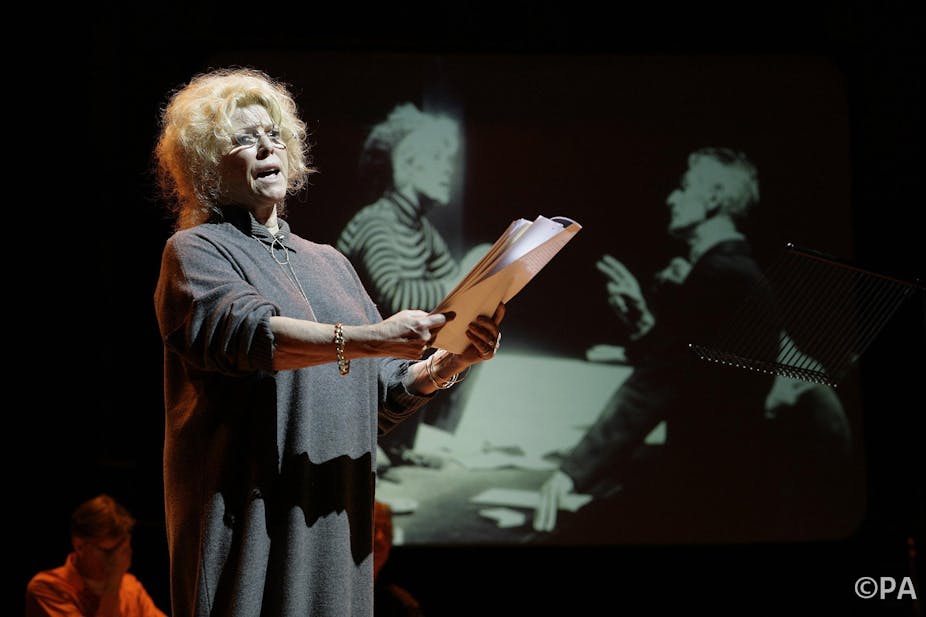In rehearsal for the 1976 premiere production of Footfalls at the Royal Court in London, Billie Whitelaw recounted Samuel Beckett’s direction:
When we rehearsed eyeball to eyeball, he opened up in me whatever there was to open up … I can still hear him saying ‘Too much colour, Billie, too much colour’. That was his way of saying ‘Don’t act’. He wanted the essence of you to come out.
In Footfalls, the ghostly figure of May walks up and down a narrow strip of light, the sounds of her footsteps, “however faint they fall”, a necessary assurance of her being, her existence. Beckett, influenced by a Carl Jung lecture he attended in the 1930s, described the scenario by saying it was as if May had never been fully born. Beckett directed Whitelaw as May with arms crossed tightly over her breast, clutching herself with claw-like hands as if to hold her flimsy persona together – so much so that the actor suffered lingering pains. With her costume designed by Jocelyn Herbert, the image of Whitelaw in this ghastly pose, half lit and in tatters, has become iconic in the Beckett canon.
It is somewhat cliched at this point to remark on the intensity of the physical demands Beckett’s drama places upon an actor. Yet the physical endurance which the Beckett actor undergoes, perhaps Whitelaw most of all, is remarkable. His plays so often limit an actor’s resources severely. He leaves them limbless in urns in Play, buried to the neck in the second act of Happy Days – a part which Whitelaw also mastered – or in genuine distress and suffering in Not I, where the actor is plunged into darkness, harnessed atop a scaffold with only a small light on her mouth, babbling a torrent of words with huge intensity.
Whitelaw spoke of how every play of Beckett’s caused her some sort of physical pain and often mental distress. She described Not I as the most demanding part of all. But pain, nausea and extreme fear are only the physical demands Beckett exacts. When he asked Whitelaw, as above, to take out the “colour”, he was really asking that she renounce the resources of drama: natural speech, character motivation and coherent narrative, as well as a fully visible and mobile body with which to communicate. Whitelaw not only accepted these demands in full; she embraced them and gave herself over completely to the rhythm, shape, sound and movement of a piece.
It was this ability of hers, to accept what is so counter-intuitive to the actor, which made her such a favourite of the author. Where other actors demanded to understand their character, to know where they came from, what they wanted, who they were and so forth, Whitelaw and all the other greatest Beckett actors, took as their source the form of the play. Such actors look not to the internal drivers of the psyche, but to sound, image, and movement.
Whitelaw’s sense of herself as pictorial material in the production of Footfalls is telling. She commented that she felt like a kinetic painting, with Beckett using her to play the notes as he painted in the lines, while simultaneously erasing them, so that she, as May, was always on the verge of disappearance. In Not I, the erasure is near-complete, as the actor is reduced to a voice birthing words at speed. Whitelaw showed herself time and again to be able to absorb Beckett’s rhythms, giving them the half-formed life that he intended. Never too much colour.
And what remains? With Whitelaw’s passing, the dramatic world has lost someone of great skill, sensitivity and talent. We have also lost a living connection to one of the 20th century’s greatest writers. Now only certain traces remain. But the years to come are sure to make her legacy concrete. Whitelaw’s footfalls, however faint in the passing of time, will echo in the years to come.

